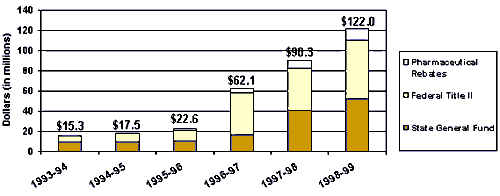
 |
|
|
Toward 2000: An HIV/AIDS
| |||
 |
|
Ensuring the Availability of New and Existing Drug Therapies Through ADAPAdequate funding is also critical to ensure that the ADAP formulary (the list of drugs covered by the program) is as comprehensive as possible. Pharmaceutical therapies for HIV disease are in an age of rapid innovation. With each new generation of drugs, important advances are made in therapeutic outcomes, ease of adherence to recommended dosing schedules, and reduction in unintended side effects. For these reasons, it is important that newly approved HIV therapies be made available through the ADAP program as quickly as possible. In general, California has been committed to this goal and all 14 HIV antiretrovirals (i.e., drugs that directly suppress the activity and/or reproduction of HIV) approved by the Federal Food and Drug Administration are now included in California's ADAP formulary. Ensuring the rapid addition of newly approved HIV drugs, while maintaining access to existing ones, is essential. In addition to drugs that work to directly alter the effects of HIV on the body, other treatments that address conditions or symptoms associated with HIV disease are crucial to the health status of Californians being treated for HIV/AIDS. In FY 1998-1999, policy makers in California approved ADAP funding levels necessary to significantly expand the state's ADAP formulary to include fifty such drugs. Continuing to update the ADAP formulary--and ensuring funding to do so--will be critical in the years ahead. ADAP CentralizationIn 1997 and 1998, in order to reduce costs and maximize the use of ADAP dollars, the state centralized the administration of the ADAP program. Previously, the program had been administered by forty-eight local health jurisdictions. It is now administered statewide by an independent entity, a pharmaceutical benefits management (PBM) company named Ramsell-PMD Corporations. This change has been extremely effective and has helped save millions of dollars by allowing the state to purchase drugs in large quantities at lower prices. It has also greatly expanded consumer access to ADAP pharmacies throughout the state. FY 1999-2000 ADAP Budget: Including state and federal sources, as well as pharmaceutical rebates, the Governor's proposed FY 1999-2000 budget increases ADAP by $14.6 million, from $121.9 million to $136.6 million (Table 1). This is good news and should ensure that California's ADAP is able to continue to serve all those who are eligible for the program. However, the budget actually includes a $4.1 million reduction in state contributions to ADAP. This is largely because of higher-than-expected federal contributions and a general slowing in state ADAP expenditures. Table 1: California ADAP Funding: FY 1998-1999 and Proposed FY 1999-2000 | ||||
| ||||||||||||||||||||||||||||||
| ||||
|
|
*The programs included in this table are
described in detail below except for Home and Community-Based Care, which
provides nurse case management and home-based care to individuals living
with AIDS and symptomatic HIV. This situation is problematic for several reasons. First and foremost, critical non-ADAP HIV care and support programs have not received notable increases in several years despite the fact that the number of people living with AIDS has grown by nearly 200% since 1993. Funding for many HIV programs has not even maintained pace with inflation, let alone growing caseloads. Second, this reduction in state funds for HIV care programs is dangerous because it could put millions of dollars in federal funds at risk. Title II of the Ryan White CARE Act contains a provision requiring states to invest resources at levels equal to those committed to HIV/AIDS in previous years. As a result, if state spending for HIV/AIDS in FY 1999-2000 is less than it is during the current year, the state is in jeopardy of losing nearly $96 million in State Title II funds. The Legislature and Administration should ensure that HIV-related programs are funded at a level that guarantees that federal funds are not in danger of being eliminated. Some of the HIV care and treatment programs most in need of additional funding include:
Recommendations - HIV Care and Treatment Services
Page last updated February 24
1999 | |||||||
| |||||||
|
|